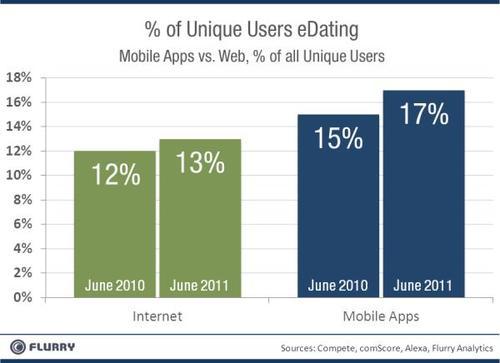Before Harry met Sally in the late ‘80s, the dating process typically involved an introduction from a friend. Then, with the Internet and email, dating evolved. By the time we were watching the movieYou’ve Got Mail - and actress Meg Ryan was cementing her status as a romantic comedy lead - the concept of online dating was going main stream.
As a social ritual, dating is a human behavior easily accelerated by technology. And it’s big business.One recent study estimated that nearly 1 in 5 singletons, who have access to the Internet, use Internet dating. Another report stated that 17% of recent marriages in the U.S. were the result of online dating websites. In size, combining North American and European markets, the online dating industry well exceeds $2 billion in revenue. Within the world of mobile apps, the largest category on iOS and Android, behind gaming, is Social Networking, in which dating apps appear. Given the voracious consumer usage we’re observing, it may also be the smartphone’s second killer app.
In this report, Flurry compares the usage of dating websites (combined desktop and mobile web) to native mobile applications over the past 12 months. For Internet consumption, we built a model using publicly available data among the top 50 dating websites from Compete.com, comScore and Alexa.com. For mobile application usage, we used Flurry Analytics data, which now tracks over 90,000 mobile applications. With respect to dating, Flurry tracks a large set of dating apps with more than 2 million total users.
Let’s start with total time spent on eDating in mobile apps versus on the web. Note that for this report, we use the term “eDating” to encompass online and mobile app dating.

As you can see, mobile dating apps now command more time compared to online dating sites: 8.4 minutes vs. 8.3 minutes. A year ago, people spent more than twice as much time on the Internet for dating as they now do in mobile apps. However, mobile app usage has increased dramatically over the last year, from 3.7 minutes in June 2010 to 8.4 minutes in June 2011, overtaking online dating time spent. These findings parallel Flurry’s recent report that showed, in total, mobile app usage has overtaken Internet usage.
In terms of engagement, frequency of use is driving growth in time spent per day in mobile dating apps. Last year, the average user opened his dating app 2 times per day, a little under 2 minutes each time. Now he opens his app over 5 times a day, but for shorter periods of time, about 1.5 minutes per session.
Next, let’s look at the proportion of people who use the Internet vs. mobile apps for eDating.

The chart above shows that dating apps are more popular on smartphones than online dating sites are on the Internet. We measured this by looking at the proportion of unique users of dating services versus the total, per platform. For the Internet, we compared unique visitors of online dating sites versus the total number of people using the Internet, which totaled 12% in June 2010 and 13% in June 2011. For mobile apps, we compared unique users of mobile dating apps versus all apps, which yielded 15% in June 2010 and 17% in June 2011.
We also found that the number of people using dating apps is growing faster than the number using all apps. In short, dating is a growth category. Overall, the number of unique users of all applications increased 125%, year-over-year, while the number of unique users using mobile dating apps increased by 150% over the same period. Comparing Internet dating to mobile app dating directly, unique users in mobile dating apps now account for about one third compared to the number of Internet dating users, which has doubled over the last year.
In an age where Facebook allows consumers to display their relationship status and easily connect to friends of friends, we speculate why mobile dating apps are gaining unprecedented traction on iOS and Android. The first reason, we believe, is that dating itself is inherently local and better served by mobile. Now, unplanned meetings of two nearby matches is more of a possibility. Secondly, it seems that mobile apps facilitate better engagement throughout the day. Today’s eDater need not be in front of her computer to view potential matches, or to receive or send messages. Her phone is always by her side. Our engagement numbers regarding frequency and session length, described above, support this trend.
iOS and Android devices are versatile multi-purpose machines that have already significantly impacted the business models of music, games and other Media & Entertainment industry categories. And now, within the nexus of mobile-social-local, mobile dating apps appear to be looking for love in all the right places.